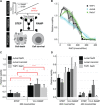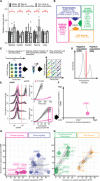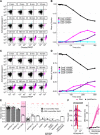Kinetics of osmotic stress regulate a cell fate switch of cell survival
- PMID: 33608274
- PMCID: PMC7895434
- DOI: 10.1126/sciadv.abe1122
Kinetics of osmotic stress regulate a cell fate switch of cell survival
Abstract
Exposure of cells to diverse types of stressful environments differentially regulates cell fate. Although many types of stresses causing this differential regulation are known, it is unknown how changes over time of the same stressor regulate cell fate. Changes in extracellular osmolarity are critically involved in physiological and pathophysiological processes in several tissues. We observe that human cells survive gradual but not acute hyperosmotic stress. We find that stress, caspase, and apoptosis signaling do not activate during gradual stress in contrast to acute treatments. Contrary to the current paradigm, we see a substantial accumulation of proline in cells treated with gradual but not acute stresses. We show that proline can protect cells from hyperosmotic stress similar to the osmoprotection in plants and bacteria. Our studies found a cell fate switch that enables cells to survive gradually changing stress environments by preventing caspase activation and protect cells through proline accumulation.
Copyright © 2021 The Authors, some rights reserved; exclusive licensee American Association for the Advancement of Science. No claim to original U.S. Government Works. Distributed under a Creative Commons Attribution NonCommercial License 4.0 (CC BY-NC).
Figures






Similar articles
-
Decrease in hyperosmotic stress-induced corneal epithelial cell apoptosis by L-carnitine.Mol Vis. 2013 Sep 19;19:1945-56. eCollection 2013. Mol Vis. 2013. PMID: 24068862 Free PMC article.
-
Osmoprotection of Bacillus subtilis through import and proteolysis of proline-containing peptides.Appl Environ Microbiol. 2013 Jan;79(2):576-87. doi: 10.1128/AEM.01934-12. Epub 2012 Nov 9. Appl Environ Microbiol. 2013. PMID: 23144141 Free PMC article.
-
Hyperosmotic stress activates p65/RelB NFkappaB in cultured cardiomyocytes with dichotomic actions on caspase activation and cell death.FEBS Lett. 2006 Jun 12;580(14):3469-76. doi: 10.1016/j.febslet.2006.05.023. Epub 2006 May 15. FEBS Lett. 2006. PMID: 16716309
-
Proline, a multifaceted signalling molecule in plant responses to abiotic stress: understanding the physiological mechanisms.Plant Biol (Stuttg). 2022 Mar;24(2):227-239. doi: 10.1111/plb.13363. Epub 2021 Nov 18. Plant Biol (Stuttg). 2022. PMID: 34796604 Review.
-
Is proline accumulation per se correlated with stress tolerance or is proline homeostasis a more critical issue?Plant Cell Environ. 2014 Feb;37(2):300-11. doi: 10.1111/pce.12157. Epub 2013 Jul 24. Plant Cell Environ. 2014. PMID: 23790054 Review.
Cited by
-
Influence of Magnesium Degradation on Schwannoma Cell Responses to Nerve Injury Using an In Vitro Injury Model.J Funct Biomater. 2024 Mar 31;15(4):88. doi: 10.3390/jfb15040088. J Funct Biomater. 2024. PMID: 38667545 Free PMC article.
-
Serum metabolomic signatures of plant-based diets and incident chronic kidney disease.Am J Clin Nutr. 2022 Jul 6;116(1):151-164. doi: 10.1093/ajcn/nqac054. Am J Clin Nutr. 2022. PMID: 35218183 Free PMC article.
-
Phenotypic consequences of logarithmic signaling in MAPK stress response.iScience. 2024 Dec 19;28(1):111625. doi: 10.1016/j.isci.2024.111625. eCollection 2025 Jan 17. iScience. 2024. PMID: 39886462 Free PMC article.
-
Osmotic pressure modulates single cell cycle dynamics inducing reversible growth arrest and reactivation of human metastatic cells.Sci Rep. 2021 Jun 29;11(1):13455. doi: 10.1038/s41598-021-92054-w. Sci Rep. 2021. PMID: 34188099 Free PMC article.
-
Rate thresholds in cell signaling have functional and phenotypic consequences in non-linear time-dependent environments.Front Cell Dev Biol. 2023 Mar 21;11:1124874. doi: 10.3389/fcell.2023.1124874. eCollection 2023. Front Cell Dev Biol. 2023. PMID: 37025183 Free PMC article. Review.
References
-
- W. Lim, B. Meyer, T. Pawson, Cell Signaling: Principles and Mechanisms (Garland Science, 2014).
-
- Burg M. B., Ferraris J. D., Dmitrieva N. I., Cellular response to hyperosmotic stresses. Physiol. Rev. 87, 1441–1474 (2007). - PubMed
-
- Cai Q., Michea L., Andrews P., Zhang Z., Rocha G., Dmitrieva N., Burg M. B., Rate of increase of osmolality determines osmotic tolerance of mouse inner medullary epithelial cells. Am. J. Physiol. Renal Physiol. 283, F792–F798 (2002). - PubMed
Publication types
MeSH terms
Substances
Grants and funding
LinkOut - more resources
Full Text Sources
Other Literature Sources

